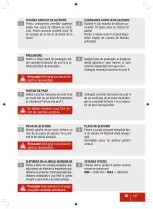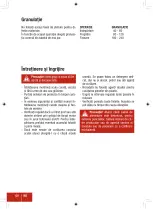
EN
116
for one minute.
Damaged accessories will
normally break apart during this test time.
h)
Wear personal protective equipment.
Depending on application, use face
shield, safety goggles or safety glasses.
As appropriate, wear dust mask, hearing
protectors, gloves and workshop apron
capable of stopping small abrasive or
workpiece fragments.
The eye protection
must be capable of stopping flying debris
generated by various operations . The dust
mask or respirator must be capable of fil-
trating particles generated by your opera-
tion. Prolonged exposure to high intensity
noise may cause hearing loss.
i)
Keep bystanders a safe distance away
from work area. Anyone entering the
work area must wear personal protec-
tive equipment.
Fragments of workpiece
or of a broken accessory may fly away and
cause injury beyond immediate area of op-
eration.
j)
Hold the power tool by insulated grip-
ping surfaces only, when performing an
operation where the cutting accessory
may contact hidden wiring or its own
cord.
Cutting accessory contacting a „live“
wire may make exposed metal parts of the
power tool „live“ and could give the opera-
tor an electric shock.
k)
Position the cord clear of the spinning
accessory.
If you lose control, the cord may
be cut or snagged and your hand or arm
may be pulled into the spinning accessory.
l)
Never lay the power tool down until the
accessory has come to a complete stop.
The spinning accessory may grab the sur-
face and pull the power tool out of your con-
trol.
m)
Do not run the power tool while carrying
it at your side.
Accidental contact with the
spinning accessory could snag your cloth-
ing, pulling the accessory into your body.
n)
Regularly clean the power tool’s air
vents.
The motor’s fan will draw the dust
inside the housing and excessive accumula-
tion of powdered metal may cause electrical
hazards.
o)
Do not operate the power tool near flam-
mable materials.
Sparks could ignite these
materials.
p)
Do not use accessories that require
liquid coolants.
Using water or other liq-
uid coolants may result in electrocution or
shock.
KICKBACK AND RELATED WARNINGS
Kickback is a sudden reaction to a pinched or
snagged rotating wheel or any other accesso-
ry. Pinching or snagging causes rapid stalling
of the rotating accessory which in turn causes
the uncontrolled power tool to be forced in the
direction opposite of the accessory’s rotation
at the point of the binding.
For example, if an abrasive wheel is snagged
or pinched by the workpiece, the edge of the
wheel that is entering into the pinch point can
dig into the surface of the material causing the
wheel to climb out or kick out. The wheel may
either jump toward or away from the operator,
depending on direction of the wheel’s move-
ment at the point of pinching. Abrasive wheels
may also break under these conditions.
Kickback is the result of power tool misuse
and/or incorrect operating procedures or con-
ditions and can be avoided by taking proper
precautions as given below.
a)
Maintain a firm grip on the power tool
and position your body and arm to al-
low you to resist kickback forces. Al-
ways use auxiliary handle, if provided,
for maximum control over kickback
or torque reaction during start-up.
The
operator can control torque reactions or
kickback forces, if proper precautions are
taken.
b)
Never place your hand near the rotating
accessory.
Accessory may kickback over
your hand.
c)
Do not position your body in the area
where power tool will move if kickback
occurs.
Kickback will propel the tool in di-
rection opposite to the wheel’s movement at
the point of snagging.
Summary of Contents for Pattfield PWD750T
Page 1: ......
Page 7: ......
Page 8: ......
Page 9: ......
Page 10: ......
Page 11: ......
Page 12: ......
Page 13: ......
Page 14: ......
Page 15: ......
Page 21: ......
Page 22: ......
Page 23: ......
Page 24: ......
Page 25: ......
Page 26: ......
Page 27: ......
Page 28: ......
Page 29: ......
Page 35: ......
Page 36: ......
Page 37: ......
Page 38: ......
Page 39: ......
Page 40: ......
Page 41: ......
Page 42: ......
Page 43: ......
Page 49: ......
Page 50: ......
Page 51: ......
Page 52: ......
Page 53: ......
Page 54: ......
Page 55: ......
Page 56: ......
Page 57: ......
Page 62: ...SV 62...
Page 63: ......
Page 64: ......
Page 65: ......
Page 66: ......
Page 67: ......
Page 68: ......
Page 69: ......
Page 70: ......
Page 71: ......
Page 77: ......
Page 78: ......
Page 79: ......
Page 80: ......
Page 81: ......
Page 82: ......
Page 83: ......
Page 84: ......
Page 85: ......
Page 91: ......
Page 92: ......
Page 93: ......
Page 94: ......
Page 95: ......
Page 96: ......
Page 97: ......
Page 98: ......
Page 99: ......
Page 105: ......
Page 106: ......
Page 107: ......
Page 108: ......
Page 109: ......
Page 110: ......
Page 111: ......
Page 112: ......
Page 113: ......
Page 118: ...EN 118...
Page 119: ......
Page 120: ......
Page 121: ......
Page 122: ......
Page 123: ......
Page 124: ......
Page 125: ......
Page 126: ......











































